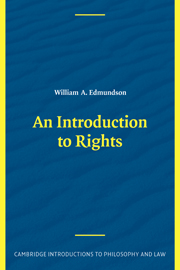Book contents
- Frontmatter
- Contents
- List of Tables
- Preface
- Part One The First Expansionary Era
- Part Two The Second Expansionary Era
- 6 The Universal Declaration, and a Revolt Against Utilitarianism
- 7 The Nature of Rights: “Choice” Theory and “Interest” Theory
- 8 A Right to Do Wrong? Two Conceptions of Moral Rights
- 9 The Pressure of Consequentialism
- 10 What Is Interference
- 11 The Future of Rights
- 12 Conclusion
- Bibliographical Notes
- References
- Index
8 - A Right to Do Wrong? Two Conceptions of Moral Rights
Two Conceptions of Moral Rights
Published online by Cambridge University Press: 08 January 2010
- Frontmatter
- Contents
- List of Tables
- Preface
- Part One The First Expansionary Era
- Part Two The Second Expansionary Era
- 6 The Universal Declaration, and a Revolt Against Utilitarianism
- 7 The Nature of Rights: “Choice” Theory and “Interest” Theory
- 8 A Right to Do Wrong? Two Conceptions of Moral Rights
- 9 The Pressure of Consequentialism
- 10 What Is Interference
- 11 The Future of Rights
- 12 Conclusion
- Bibliographical Notes
- References
- Index
Summary
Beginning with the set of Hohfeldian elements, it is possible to design any number of molecular combinations that may come closer to approximating what we mean by a moral right than any of those elements in isolation. In the last chapter, we looked at the particular molecule favored by Choice Theory of legal rights, and considered the question whether that molecule was also distinctive of moral rights. Another common suggestion about moral rights (and moral, rather than legal, rights will be the focus of this chapter) is that a person X's moral right to φ is a precise bundle of Hohfeldian elements consisting of a moral claim-right against interference by Y with X's φ-ing, a moral claim-right against interference by Y with X's not φ-ing, coupled with X's moral permissions both to φ and not to φ – that is, with the absence of a moral duty either to φ or not to φ. This is to be taken as a proposed stipulation of what is to be understood by talk of a moral right. The force of such rights will be brought out (in part) by unpacking what is meant by interference. The scope of the right will be brought out by specifying the range of persons and entities Y who are duty-bound not to interfere. And the substance of the right will be the action, φ-ing, that the right-holder has a moral option to do or omit.
- Type
- Chapter
- Information
- An Introduction to Rights , pp. 133 - 142Publisher: Cambridge University PressPrint publication year: 2004

